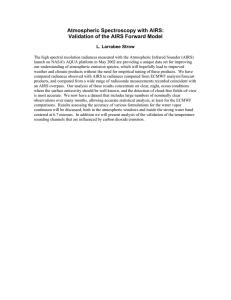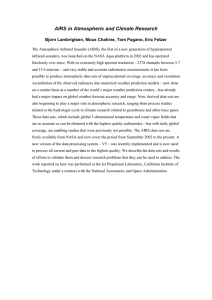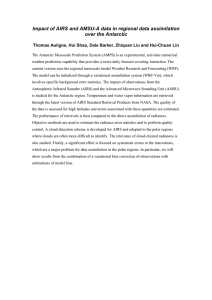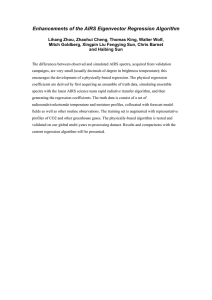RA V Training Workshop on Satellite Applications for Meteorology and... Citeko, Bogor – Indonesia, 23 September 2011
advertisement
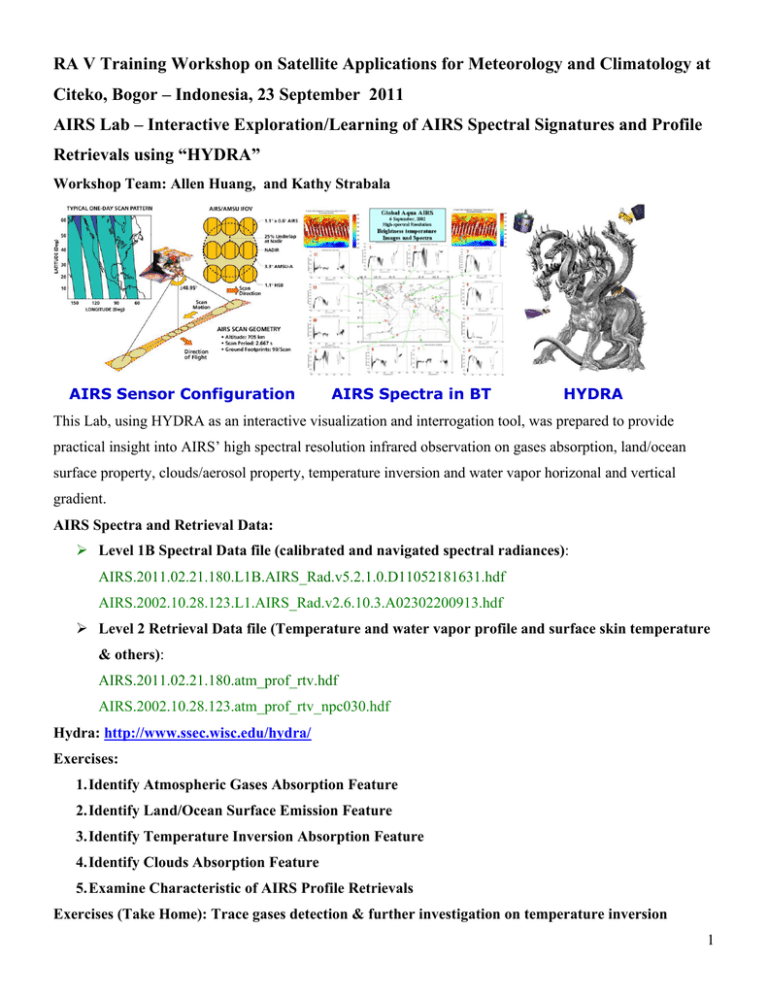
RA V Training Workshop on Satellite Applications for Meteorology and Climatology at Citeko, Bogor – Indonesia, 23 September 2011 AIRS Lab – Interactive Exploration/Learning of AIRS Spectral Signatures and Profile Retrievals using “HYDRA” Workshop Team: Allen Huang, and Kathy Strabala AIRS Sensor Configuration AIRS Spectra in BT HYDRA This Lab, using HYDRA as an interactive visualization and interrogation tool, was prepared to provide practical insight into AIRS’ high spectral resolution infrared observation on gases absorption, land/ocean surface property, clouds/aerosol property, temperature inversion and water vapor horizonal and vertical gradient. AIRS Spectra and Retrieval Data: Level 1B Spectral Data file (calibrated and navigated spectral radiances): AIRS.2011.02.21.180.L1B.AIRS_Rad.v5.2.1.0.D11052181631.hdf AIRS.2002.10.28.123.L1.AIRS_Rad.v2.6.10.3.A02302200913.hdf Level 2 Retrieval Data file (Temperature and water vapor profile and surface skin temperature & others): AIRS.2011.02.21.180.atm_prof_rtv.hdf AIRS.2002.10.28.123.atm_prof_rtv_npc030.hdf Hydra: http://www.ssec.wisc.edu/hydra/ Exercises: 1. Identify Atmospheric Gases Absorption Feature 2. Identify Land/Ocean Surface Emission Feature 3. Identify Temperature Inversion Absorption Feature 4. Identify Clouds Absorption Feature 5. Examine Characteristic of AIRS Profile Retrievals Exercises (Take Home): Trace gases detection & further investigation on temperature inversion 1 Exercise 1 - Identify Atmospheric Gases Absorption Features The goal of this exercise is to gain an understanding of water vapor molecular, CO2, and O3 absorption and its spectral characteristics in the infrared portion of the spectrum (2700 1/cm [] to 650 1/cm []) Atmospheric gases’ absorptions effect on AIRS brightness temperature spectrum (also see REFERENCE for more details) 1. Open Hydra and load level 1B data file: AIRS.2011.02.21.180.L1B.AIRS_Rad.v5.2.1.0.D11052181631.hdf Click on Start to open the MultiChannel Viewer . Engage the reference spectrum icon (click on Tools and find Reference Spectrum and click both “on” & “global”). Click second “arrow” box from the left [the one without the “red square around it”] and click on the selected pixel near the green # (maximum brightness of wavenumber 919.47 1/cm) to display the brightness temperature spectrum (in black) which is the location in cyan (light blue) color with a cross symbol. We can then begin to explore the absorption spectral differences between the “red” (coldest) and “black” (almost warmest) spectra. 1.1 Locate CO2 absorption region (650-780 1/cm) and explain the spectral difference between “red” and “black” spectrum. (Hint: Click on the “square” icon, third box from the right and click on the spectrum window and hold and drag the cursor to zoom into the spectral region until you have a detail view of the CO2 absorption; click on spectra window and drag the currsor to the spectral region desired so you can see the brightness temperature (BT) indicated not only in the spectra but also on the number in mangenta and yellow color). 2 Figure 1.1. Left panel: Zoom in AIRS spectra of coldest and one of the warm pixels. Note that the spectral absorption is dominat by the CO2 absorption. Middle panel shows 800 1/cm brightness temperature image; Right panel~ 1.1.1 For example if one is to select the channel at 800.01 1/cm I see the coldest and warmest brightness temperatures (BT) are ~292. K vs. 232.53 K, a ~60 K difference. 1.1.2 If one to move the channel to 750.16 1/cm I scoldest and warmest brightness temperature are ~275. K vs. 229.75 K, a ~46 K difference. 1.1.3 if one to move the channel to 700.22 1/cm I see the coldest and warmest brightness temperature are 213.72 K vs. ~215 K. only a ~8 K difference. (note: the image looks very random, explain why?) Ask yourself about what these BT differences mean? 1.2 Repeat the above exercise but select the channels in ozone region (990-1070 1/cm) 1.3 Repeat the above exercise but select the channels in water vapor region (1250-1600 1/cm) Explain why the black spectrum has much more brightness temperature differences between absorption lines and the red spectrum has much smaller differences. (Note: at 1599.95 1/cm: ~266K vs. 231.20K; at 1251.3 1/cm: ~288K vs. 234.29K). In Multi-Channel Viewer Window under tools use linear combinations to compute two channel differnces: 1251.3 1/cm vs. 1599.95 1/cm). Log the minimum and maximum values of this difference image and explain what are differences really mean? (see figure 1.3 right panel for reference) 3 Figure 1.3. Comparisons of water vapor absorption features in clear and cloudy regions. 1.4 Click on “small aquare symbol” and then click and drag your cursor to form an area that you like to see the highlight of the CO2 spectral region so that you can visualize the CO2 absorption lines (weak & strong). Explain why at the strongest line (the line center) the BT differences between two spectra are so small? 1.5 Click on “small aquare symbol” and then click and drag your cursor to form an area that you like to see the highlight of the water vapor spectral region so that you can visualize the H2O absorption lines (weak & strong). Explain why at the H2O amplitude is much smaller for the red spectrum (cloudy pixel) than the black spectrum (clear pixel)? 1.6 Click on “small aquare symbol” and then click and drag your cursor to form an area that you like to see the highlight of the shortwave window spectral region (2400-2600 1/cm). Explain why BT spectral variation is so small? 1.7 Select two darkest (warmest) pixel and to siaplay their BT spectra and compare their spectral differences to ask yourself about the temperaute and water vapor variation of these two locations. Load AIRS.2010.07.31.155.L1B.AIRS_Rad.v5.0.0.0.G10213110759.hdf and repeat the above exercise Exercise 2 - Identify Land/Ocean Surface Emission (due to emission and reflection of the earth surface) Features The goal of this exercise is to gain an understanding of land and ocean surface emission due to surface type, vegetation coverage, soil composition and ocean surface roughness and its spectral characteristics in the infrared portion of the spectrum 4 Earth surface emissivity (i.e. types) effects on AIRS spectral brightness temperature 2.1 Open Hydra and load level 1B data file: AIRS.2011.11.11.063.L1B.AIRS_Rad.v5.0.0.0.G10315132418.hdf 5 Under Start open the MultiChannel Viewer . Engage the reference spectrum icon (look under Tools and find Reference Spectrum and click on). Figure 2.1.1 Scene selected for the investigation of AIRS spectral feature over ocean and land. Select clear area with one over ocean and pne over land such as figure 2.1.1 shown above. Explain what are differences between these two spectra: Any differences in longwave IR window region between 850-1000 1/cm How about the spectral difference between 1070-1135 1/cm Any significant differences in each spectrum between longwave side and shortwave side of ozone band (9901070 1/cm)? 6 Use figure above as a reference to assist your interpretation of surface spectral feature of ocean and land surface. Can you classify/identify what land surface type (i.e. vegetated, forest, or sand/desert ….)? Go to Tools and select “Linear Combination” to compute difference for chair pair of 919.47/1130.15 1/cm. Explain why the differences are small in ocean region? Explain why the difference are large for some area and small (but still larger than ocean pixels)? Exercise 3 - Identify strong Temperature Lapse Rate or Temperature Inversion (increase temperature with decrease pressure [or height increase]) Absorption Feature The goal of this exercise is to gain an understanding of how AIRS spectral characteristics in the infrared portion of the spectrum can easily detect the vertical temperature changes (either decrease or increase with height) 7 Illustration of AIRS spectral signature on temperature inversion in tropopause & boundary layer 3.1 Open Hydra and load level 1B data file: AIRS.2011.02.21.180.L1B.AIRS_Rad.v5.2.1.0.D11052181631.hdf Under Start open the MultiChannel Viewer . Engage the reference spectrum icon (look under Tools and find Reference Spectrum and click on). Click on Load to open AIRS retrieval for this scene found in “AIRS.2011.02.21.180.atm_prof_rtv.hdf” (leave the Multichannel Viewer with AIRS level 1B data open). Under Variables select Air Temperature Profiles and under Tools turn Reference Profile on. In MultiChannel Viewer, using the arrows in the bottom tool bar select one FOV/pixel in clear land and clear ocean area. The red dot pixel with red spectrum comapres with the cyan cross pixel over clear land area are selected. The spectral is zoom in using the third bottom from the right (at lower left corner of the Multi-Channel Viwer window) to center the spectral plot around 871 1/cm. As can be seen the red spectrum displays large differences between on-line and off-line channels. On the countrary, the on-line and off-line differences are 8 very small for the pixel located in clear land area indicated by the balck spectrum. On the Hydra level2 products window the magenta trmperature profile inciates large temperature lapse rate near the surface. The black temperature profile curve derived from the associated black spectrum exibits much smaller vertical temperature change near the surface. Find other pairs of retirevals that might have similar spectral features and see one might to explore the temperature inversion near surface or over tropopause level. Figure 3.1. Spectral signature of the weak water vapor lines are indicative of how strong the temperature lapse rate and also potential temperature inversion may occure. Left panel showing two spectra which have very different on-line and off-line differences. Large on-line and off-line differences are reflect in the AIRS level 2 air temperature retireval as shown in the right panel. Another example of temperature profile differences in the lower tropospere and above tropause is shown in figure 3.2. Note that black spectrum is warm than red spectrum for those wavenumbers larger than ~697 1/cm. The air temperature retrieval reflect this inflection where below 250 mb the south pixel (magenta cross cursor) has warmer temperature profile and above 250 mb it’s much colder than its northern pixel’s retrieval. 9 Figure 3.2. Another example of vertical temperature structure is captured by the AIRS spectra. Exercise 4 - Identify Clouds Absorption Feature The goal of this exercise is to gain understanding of absorptions caused by water, ice and mixed phase (both ice and water) clouds and their spectral characteristics in the infrared portion of the spectrum Microphysical property of clouds and their effect on AIRS spectral brightness temperature 4.1 Open Hydra and load level 1B data file: AIRS.2011.02.21.180.L1B.AIRS_Rad.v5.2.1.0.D11052181631.hdf Under Start open the MultiChannel Viewer . Engage the reference spectrum icon (look under Tools and find Linear Combination and click on). Select channel 989.92 1/cm minus channel 870.00 1/cm and click Compute 4.1.1 Click on Settings and click on Set color Range to set histogram minimum as zero. Visualize and compare Click on Settings and set color scale to color. Explain those green areas might belong to what type of scenes (clouds or clear?; if clouds what type of clouds [ice or water cloud?]) 10 4.1.2 Repeat 4.1.1 but set histogram maximum as zero and see any significant feature that is unique and different to the result found on 4.1.1 4.1.3 Move both pixels to the coldest location (233.46 K @ 899.97 1/cm) and other cloudy pixel (240.48 K @ 899.97 1/cm). Zoom in the spectral region between 690 to 720 1/cm. Also in Hydra AIRS level 2 Products Window under Variables click on air temperature profile. Examine the left panel of Figure 4.1 show below and discuss what you see in the two spectra. Have you noticed that the red and balck spectra cross each other at wavenumber near 702.74 1/cm? For those spectral channels their wavenumber smaller than 702.72 1/cm the red spectral channels are warmer than black spectral channels. For thoese channels larger than 702.72 1/cm the black spectral channels are warmer than the red ones. Explain what happens here? Why both pixels’ brightness temperature is so close (219.84 K vs. 219.28 K)? Are these temperature close to the retirved temperature near 200 mb? Have you also noticed that the differences of the two retrieved air temperature above and below 200 mb level change sign? Figure 4.1. Exercise 5 - Examine Characteristic of AIRS Profile Retrievals The goal of this exercise is to gain an understanding the characteristic of AIRS temperature and water vapor profile retrievals 11 Fundamental releationship between AIRS spectral brightness temperature and temperature profile 5.1 Open Hydra and load level 1B data file: AIRS.2011.02.21.180.L1B.AIRS_Rad.v5.2.1.0.D11052181631.hdf Under Start open the MultiChannel Viewer. Under Tools click on Reference spectrum and click “on”. Click on Load to open AIRS retrieval for this scene found in “AIRS.2011.02.21.180.atm_prof_rtv.hdf” (leave the Multichannel Viewer with AIRS level 1B data open). Under Variables select Air Temperature Profiles and under Tools turn Reference Profile on. In Multi-Channel Viewer, using the arrows in the bottom tool bar select one FOV/pixel directly in the cloud (near Hainan Island) and another IFOV/pixel nearby in clear skies. 5.1.1 Observe the characteristic spectral signature of an opaque (high cold cloud) in the Multi-Channel Viewer (fig. 5.1 below). Now observe the temperature profiles for the two FOVs in the Hydra AIRS retrieval level 2 products window (fig. 5.1 below). 12 5.1.2 Can you estimate the height of the opaque cloud (Hint: The height where the temperature of the two retrievals (clear and cloudy) begins to differ)? 5.1.3 Inspect the temperature retrieval image for various pressure levels (in the Hydra AIRS level 2 Products Window use the first arrow in the bottom tool bar to move the horizontal green line to different pressure levels); the pressure level where the retrieval field shows large contrast over the cloud is indicative of its height. 5.1.4 Explore the spectra and the inferred height of several other clouds in the scene. Record their location and your estimate of their height. Figure 5.1: (right) MultiChannel Viewer display with reference spectrum on showing cloudy and clear sky AIRS spectra near the Hainan island. (left) AIRS temperature profile retrievals in clear and cloudy FOVs and the 300 hPa temperature retrieval field for the granule. 5.2 In the Hydra AIRS level 2 Products Window, under Variables select Water Vapor Profiles. 5.2.1 Inspect the moisture retrieval image for 900 hPa. The South Western Taiwan Sea appears to have more low level moisture than the eastern part. In the Multi-Channel Viewer display two spectra, one for a FOV in the moister region and one in the drier region in the east coast of China near west of Taiwan. Zoom in on the two spectra at 870 cm-1 (click on the icon third from the right in the bottom tool and then click and drag over the appropriate part of the spectrum – repeat until full resolution of the absorption lines in the IR window are apparent). You should have something that looks like Figure 5.2. 5.2.2 Does the on-line off-line brightness temperature difference in this part of the spectrum agree with the inference from the retrieval field? Note that the on-line and off-line differences for black spectrum (cyan cross pixel) are much smaller than the differences for red spectrum (red dot pixel). 13 Figure 5.2. (Right) MultiChannel Viewer display with zoom in on IR window spectra near 872 cm-1 over FOVs in in the east coast of China near west of Taiwan. (Left) AIRS water vapor profile retrievals in the two selected FOVs and the 900 hPa water vapor retrieval field for the granule. 5.3 Repeat the investigation of atmospheric water vapor retrieval by displaying 1443 1/cm brightness temperature in the Multi-Channel Viewer. Can you see between 500 to 800 mb layers the water vapor concentration changed so that the original moist area become drier and the dry area becomes wetter. This is the demonstration of vertical resolving power of AIRS which can detect vertical moisture distribution from pixel to pixel with different gradient of water vapor at various vertical layers. Note that the red and black spectra differences are much smaller than the difference centered around 872 1/cm due to water vapor are much higher in the layer near 700 mb layer for pixel indicated by the black spectrum. Also despite the red dot pixel has higher temperature than cyan cross pixel the difference between on-line and off-line channels are much bigger than spectral region centered around 872 1/cm and these differences are almost the same for both red dot and cyan cross pixels. Optional Take Home Exercise - SO2 Detection The goal of this exercise is to gain an understanding of trace gas detection using high spectral resolution infrared data. Using Hydra load AIRS.2002.10.28.123.L1.AIRS_Rad.v2.6.10.3.A02302200913.hdf. This granule includes the eruption of Mount Etna on 28 October 2002 (see Figure O1). 14 Figure O1a. AIRS measurements over eruption of Mount Etna on 28 October 2002 Figure O1b. (top) Simulated AIRS spectrum from 1320 cm-1 to 1441 cm-1. (bottom) Differences between the simulated AIRS spectrum with and without climatological amounts of SO2. The bottom plot simply indicates the position of the SO2 absortpion lines. (a) Using Combine Channels calculate the difference between two wavenumber, AAAA.A and BBBB.B, that could be used to detect SO2. How would you determine the optimal values for these wavenumbers? 15 (b) With a broadband instrument like AVHRR we would have used the difference 833.3 minus 909.0 cm-1 (12 – 11 microns). Map this difference into a different pseudo channel. How do the two figures compare? (c) Select a single spectrum over the smoke plume. Verify that the spectrum has a peak around 1227.3 cm-1. Calculate the difference between 1123.0 and 1227.3 wavenumber, and map it onto the Y axes. Now calculate the differece between 1376.886 and 1414.008 and map it onto the X axes (this last combiniation represents the best estimate we could determine for AAAA.AA and BBBB.BB). Explain the differences between the pseudo-channels with the help of the scatter plot. (d) Map the difference [(BT1123.0 – BT1227.3) – (BT1376.886 – BT1414.008)] to the X axis and 907.68 (window channel) to the Y axis. Get a scatter plot and look at the pseudo-channel mapped onto the X axis. Try to describe and explain what you observe in the pseudo-channel with the help of the scatter plot. 16 Optional Take Home Exercise Temperature Inversion Investigation The goal of this exercise is to gain an understanding of high spectral resolution IR spectral signature of temperature inversion. Using Hydra load AIRS.2002.10.28.123.atm_prof_rtv_npc030.hdf which contains the AIRS retrievals for this scene (leave the Multichannel Viewer with the AIRS data open). Under Variables select Air Temperture Profiles. Under Tools turn Reference Profile on. In the Multichannel Viewer turn Reference Spectrum on also. Using the arrows in the bottom tool bar select one FOV directly in the ask plume and another FOV nearby in clear skies. Observe the characteristic spectral signature of ash in the Multi-Channel Viewer. Observe the temperature profiles for the two FOVs in the Hydra AIRS level 2 Products Window. (a) What can you infer about the height of the ash plume? Why? Inspect the temperature retrieval image for various pressure levels (in the Hydra AIRS level 2 Products Window use the first arrow in the bottom tool bar to move the horizontal green line to different pressure levels); the pressure level where the retrieval field shows large contrast over the ash plume is indicative of its height. Consider the AIRS measurements in the CO2 region of the spectrum (see Figure O2). In the spectral regions where the red dots indicate the AIRS channel the online channels are warmer than the offline channels, can 17 you explain why? In the spectral region where the magenta circles indicate the AIRS channels the on-line channels are colder than the off-line channels, what is the difference between the two spectral regions? Figure O2. AIRS normalized spectrum (blue) and locations of CO2 lines (green). (a) Using figure O2, plot a map of the tropopause temperature for the granule over Italy (determine wich channel in your opinion has the peak of the wighting function at the tropopause, and explain how did you select it) 18 REFERENCES: AIRS Grating Spectrometer Measurement Principal: Radiative Transfer Equation: 19 AIRS Gases Absorption Illustrations: 20 Land Surface types identification and coverages retrieval: 21 Cloudy brightness temperature spectra: Dust and cirrus spectral absorpation characteristics: 22 AIRS volcanic SO2 and ashes spectral signature: 23
